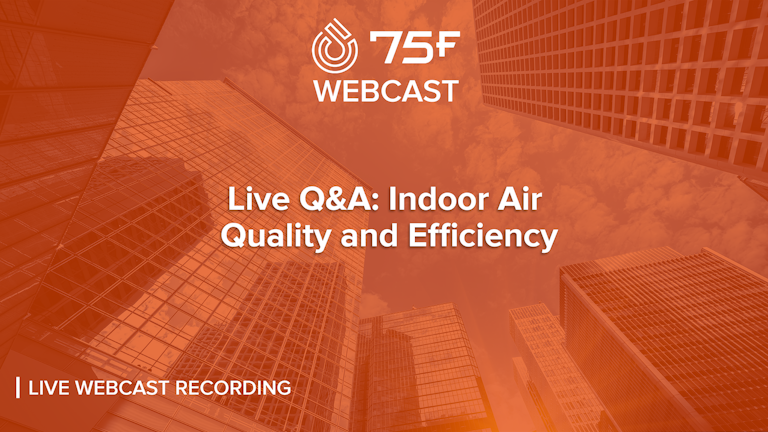
Healthier Buildings Series: Q&A on IAQ and Efficiency
In this webcast session, 75F's Bob French hosts a live Q&A to tackle viewers' questions about indoor air quality and energy efficiency as the commercial buildings landscape undergoes a fundamental shift.
We've compiled a few of the questions with summarized answers below — read on or watch the full session for more detail!
Indoor Air Quality
"Does 75F use any wireless wall sensors or IAQ sensors, or have any plans to use them?" — Gustave
The 75F solution offers two built-in methods for delivering this data. The 75F HyperStat™ — the smartest thermostat in the world — is a thermostat and IAQ sensing station combined. It senses temperature, humidity, VOCs, CO2, lighting, sound, occupancy, and optional particulate matter for improved air quality and comfort.
Additionally, 75F's Outside Air Optimization solution kit includes a CO2 sensor, which is a good indicator of occupancy and ventilation rates.
"What are the IAQ thresholds that 75F uses to trigger ventilation/filtration, or are they customizable? Are they direct triggers, or is it an algorithm of an overall air quality index?" — Lukas
With demand-control ventilation (DCV), the default setting is 1,000 ppm. However, 75F users can also control the rate at which dampers open with editable tuners, which 75F's AI factors into its control decisions.
"Do you expect IAQ to remain a focus, even after a successful vaccine rollout, or do you expect the focus to shift back towards energy efficiency?" — Howard
In Bob's experience over the last 10 years, energy efficiency was more important than comfort and far outweighed health and wellness in commercial buildings. However, that hierarchy of values has completely flipped. Now, health and wellness are top of mind, and Bob believes this trend will last into the foreseeable future.
"In your opinion, which is better/more accurate, to run OSA required based on CO2 levels, or on persons in the space?" — Nathaniel
In Bob's opinion, the persons in the space is the more accurate number. CO2 levels are used as a proxy for what occupancy is because it's so easy to measure. People counting and managing occupancy is a trend that Bob thinks is here to stay.
Energy Efficiency
"With the recent push for IAQ, do you see more exceptions for equipment efficiencies being allowed for th emore stringent code areas like CA with Title 24?" — Nathaniel
The push for IAQ definitely does affect efficiency. Increasing outdoor air ventilation during a pandemic, for example, is not an efficiency measure. It's pricey to cool down hot, humid air, and the same goes for treating frigid air.
As to whether this new reality is going to change the rules, Bob doesn't know. He thinks everyone is making an exception right now because health is the top priority — but whether this will be codified, he can't say for sure.
"Can you generally address the trade-offs between IAQ and energy efficiency? Are there strategies to mitigate any energy penalty from improvements in IAQ?" — Michael
If you are only looking at ventilation rates and bringing in more outside air, there is definitely a correlation between an increase in energy consumption and the improvement of IAQ.
When applied thoughtfully, building automation can help mitigate energy penalties associated with increased outdoor air ventilation.
"Can you set alerts for a drop in average efficiency on a particular piece of equipment in 75F's dashboard so that any maintenance can be addressed?" — Nathaniel
Yes. In fact, we are coming out with an update to our notifications platform, which will be incredibly powerful, and you'll be able to send notifications on any point. Our analytics dashboard has a whole notification feature set coming out in which you will be able to analyze any point and create any type of visualization you want with alerts.
You will be able to have these alerts sent to any person who is a user set up in the platform. And you'll also be able to mute these alerts, either individually for a temporary period of time, or permanently.











